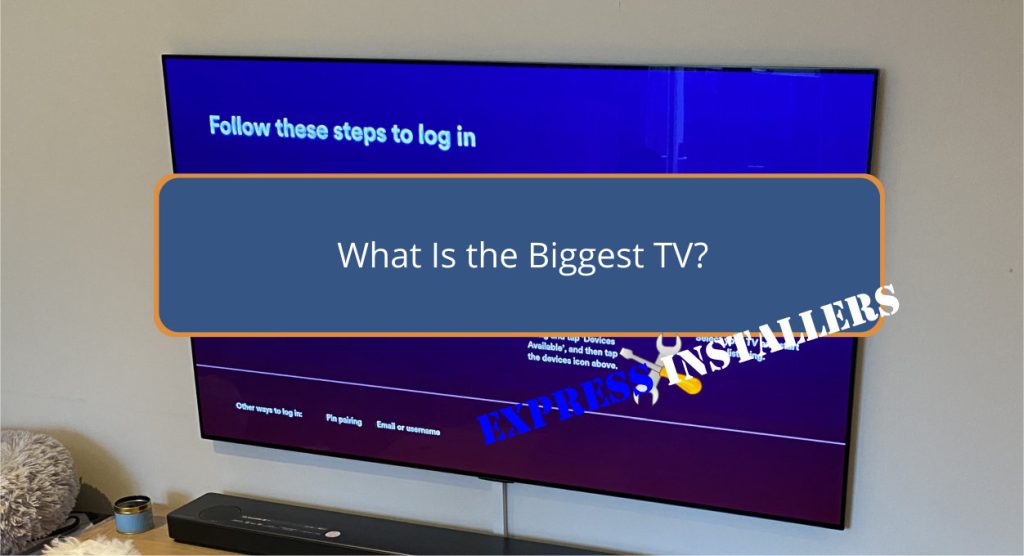
Samsung’s ‘The Wall‘ is currently the largest TV you can get, scaling up to a massive 292 inches. Utilizing advanced MicroLED technology, it’s fully customizable in size and shape, redefining luxury home entertainment.
This TV responds to the market’s demand for bigger and better screens, leveraging superior 8K resolution and innovative features.
Rival brands like LG also compete with groundbreaking technologies, pushing the envelope in size and immersive experiences.
As market trends shift towards larger screens, manufacturers continue to innovate and offer more impressive options.
For detailed insights on these colossal screens and future trends, stay tuned.
Samsung’s ‘The Wall,’ with its staggering size of up to 292 inches, delivers an unparalleled viewing experience that redefines luxury home entertainment. You can customize its size, shape, and aspect ratio to match your specific preferences, making it a versatile choice for high-end setups.
Market trends show a growing demand for personalized and immersive home entertainment solutions, and The Wall caters to this niche perfectly. It’s designed for consumers who prioritize premium quality and are willing to invest in cutting-edge technology.
Leveraging advancements in Direct View LED and MicroLED technologies, the engineering marvels behind large TVs like LG’s Extreme Home Cinema and Samsung’s The Wall are transforming the landscape of luxury home entertainment.
LG’s Extreme Home Cinema offers customizable screen sizes from 108 to 325 inches, utilizing Direct View LED for unparalleled resolution options.
Meanwhile, Samsung’s MicroLED panels enable modular configurations, allowing The Wall to scale up to 1,000 inches. These innovations cater to high-end consumers and super-luxury homes, aiming for an immersive viewing experience.
The intense competition between LG and Samsung drives continuous innovation, pushing boundaries in screen size and technology, ensuring that the market remains dynamic and ever-evolving.
As the technology driving large TVs continues to evolve, the benefits of bigger screens offer an unparalleled cinematic experience that captivates consumers and redefines home entertainment standards. Research by Samsung and IA Collaborative shows 8 out of 10 consumers switch to bigger screens without regret. Here are three key benefits:
These factors underscore why larger screens are increasingly popular, as they offer value and satisfaction that smaller screens can’t match.
In today’s market, comparing large TV brands like LG and Samsung reveals a fierce competition to dominate the high-end segment with groundbreaking innovations and ultra-large screens.
LG’s Extreme Home Cinema TV boasts a colossal 325-inch screen using Direct View LED technology, 8K resolution, and the UltraStretch feature for multitasking TV channels.
On the other hand, Samsung’s The Wall offers modular MicroLED panels that can scale up to an astonishing 1,000 inches, providing customizable screen sizes.
Both brands target super-luxury homes, reflecting changing consumer preferences and driving market innovation.
As LG and Samsung push technological boundaries, they continually redefine the possibilities of home entertainment, catering to high-end consumers seeking the ultimate viewing experience.
The future of massive TVs is poised for a significant transformation, with manufacturers like TCL and Hisense leading the charge to surpass the triple-digit size barrier and redefine home entertainment.
TCL’s upcoming 115-inch TV, featuring Quantum dot color technology and 20,000 local dimming zones, is set to go on sale by mid-2024 at around $20,000. Meanwhile, Hisense offers a more budget-friendly 100-inch alternative. Market trends show a clear shift towards larger screens, with 98-inch TVs now considered outdated.
Key factors to watch include:
These trends indicate a booming future for colossal TVs.
You’re looking at over 325 inches for the biggest TV. LG’s Extreme Home Cinema TV, using Direct View LED technology, offers 8K resolution. It’s customizable and comes with extensive support, reflecting the luxury trend in the market.
Yes, you can find 120 inch TVs on the market. These ultra-large screens cater to consumers seeking a cinematic home experience. Major manufacturers offer these models, aligning with trends for immersive, expansive entertainment.
The max size of a TV currently available for general consumers is 98 inches. For ultra-luxury markets, LG’s customizable Extreme Home Cinema TV ranges from 108 to 325 inches, though these require significant space and high maintenance costs.
Yes, there’s a 300-inch TV. LG’s Extreme Home Cinema exceeds 325 inches, using Direct View LED tech. Custom-built, it’s not for general purchase and costs over $100,000. Market trends show increasing demand for ultra-large screens.
To sum up, as you delve into the world of massive TVs, Samsung’s ‘The Wall‘ stands out due to its cutting-edge technology and impressive size.
Bigger screens provide immersive viewing experiences, making them a popular choice among consumers.
By comparing large TV brands, you’ll notice Samsung leads with innovative features and market dominance.
Future trends indicate that even larger, more advanced TVs will continue to captivate audiences, driven by consumer demand and technological advancements.
Mon-Fri: 24 Hours
Sat: 24 Hours
Sun: 24 Hours